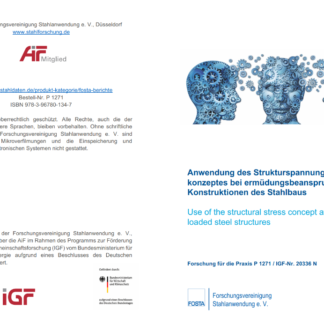Description
P 1271 – Use of the structural stress concept at fatigue loaded steel structures
This final report on the application of the structural stress concept for steel structures under fatigue loading deals with structural stress-oriented evaluation approaches to the structural details longitudinal stiffener, transverse stiffener and cruciform joint. Particular attention is directed to the effects of manufacturing-related imperfections and thickness effects, which are investigated by means of suitable FE analyses and indirect stress-increasing factors. Extensive parameter studies on FE shell and solid models are carried out for this objective. The numerical results are being verified using in-house experimental tests.
For this purpose, static tensile and bending tests as well as experimental fatigue tests are performed and evaluated. With the help of the results, the economic applicability of the structural stress concept compared to the nominal stress concept can be verified on the one hand. On the other hand, specifications for the effects from imperfections and thickness effects can be determined, since the investigated test series are partially executed with intentional imperfections and different thicknesses. 3D laser scan measurements of all examined test specimens allow an exact assessment of the existing imperfections. This allows stress concentration factors for the indirect determination of stress-increasing effects to be precisely determined and existing regulations to be verified.
The results of the evaluations indicate that the structural stress concept for ground plates with longitudinal stiffeners that are welded on both sides is not economically applicable in a large number of cases. However, the static tests are evaluated based on the normative fatigue classes of the DIN EN 1993-1-9 [1], the guidelines of the International Institute of Welding [2] and the prEN 1993-1-9 [3], which are subject to a wide scatter throughout the regulations. With regard to transverse stiffeners and cruciform joints, a more significant influence from imperfections on the relevant structural stress is shown. However, the structural stress concept, based on the currently valid normative fatigue classes in the nominal and structural stress concept, an still be used economically if the normative fatigue classes are valid. Nonetheless, the fatigue tests on cruciform joints indicate that the fatigue class in the structural stress concept is classified at a level that is considered too high. In addition, it can be identified that straightening effects lead to reduced stress ranges in fatigue testing. These effects are not considered in the standards to date. Consequently, the general applicability of the structural stress concept must be critically questioned in some respects. Nevertheless, suitable regulations for its application can be established in this research project. The objective of this research project was accomplished.
All research reports in german language only!
Published in:
June 2022
Authors:
Sc. N. Rausch, Prof. Dr.-Ing. M. Mensinger


